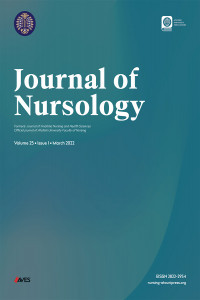HEMŞİRELİK UYGULAMALARINA YÖN VEREN ULUSLARARASI HEMŞİRELİK KURULUŞLARININ ÇEVRE SAĞLIĞI YAKLAŞIMLARI
ÖZETHemşireler, birey, aile ve toplum düzeyindeki çevre sağlığı konularını ele almada ve değerlendirmede önemli bir role sahiptirler. Birçok hemşirelik modelinde çevre ele alınmış, egosentrik ve ekosentrik bakış açısıyla değerlendirilmiştir. Hemşirelerin çevre sağlığı alanındaki rollerini yerine getirmeleri için, bu alanda tanımlanmış yeterliliklere sahip olmaları beklenmektedir. Çevre sağlığı alanında hemşirelik eğitim, uygulama ve araştırmalarını geliştirmek ve vizyon oluşturmak için yüksek öğretim kurumu, sağlık bakanlığı ve mesleki kuruluşlarla işbirliği içinde çalışılması gerekmektedir.Bu makalede uluslararası hemşirelik kuruluşları tarafından sunulan hemşirelik eğitim, uygulama ve araştırmalarına yön veren çevre sağlığı ilkeleri, çevre sağlığı alanında hemşirelerin bilgi ve becerilerini geliştirebilecek yaklaşımlar ve hemşirelerin çevre sağlığı ile ilişkili rolleri incelenmiştir.Anahtar Kelimler: çevre sağlığı; hemşirelik; yaklaşımABSTRACTEnvironmental Health Approaches in International Nursing Organizations Directing Nursing PracticesNurses play an important role in addressing and evaluating environmental health issues at the individual, family and community level. In many nursing models, the environment is considered and evaluated with an egocentric and ecocentric point of view. It is expected that nurses should have the qualifications defined in this area in order to fulfill their role in environmental health. To develop nursing education, practice and research in the area of environmental health and to form a vision, cooperation with higher education institutions, ministries of health and professional organizations is required.In this article, the environmental health principles that guide nursing education, practice and research presented by international nursing organizations, the approaches that can improve the knowledge and skills of nurses in the field of environmental health and the roles of nurses related to environmental health are examined. Keywords: environmental health; nursing; approach
Anahtar Kelimeler:
çevre sağlığı, hemşirelik, yaklaşım
Envıronmental Health Approaches in International Nursıng Organizations Directing Nursing Practices
Nurses play an important role in addressing and evaluating environmental health issues at the individual, family and community level. In many nursing models, the environment is considered and evaluated with an egocentric and ecocentric point of view. It is expected that nurses should have the qualifications defined in this area in order to fulfill their role in environmental health. To develop nursing education, practice and research in the area of environmental health and to form a vision, cooperation with higher education institutions, ministries of health and professional organizations is required. In this article, the environmental health principles that guide nursing education, practice and research presented by international nursing organizations, the approaches that can improve the knowledge and skills of nurses in the field of environmental health and the roles of nurses related to environmental health are examined.
Keywords:
environmental health, nursing, approach,
___
- 1. American Nurses Association (ANA). ANA’s Principles of Environmental Health for Nursing Practice with Implementation Strategies. American Nurses Association 2007, Silver Spring. Maryland.
- 2. American Nurses Association (ANA). Nursing: Scope and Standards of Practice. 1 st Edition American Nurses Association,2004.
- 3. American Nurses Association (ANA). Nursing: Scope and Standards of Practice 2 nd Edition. American Nurses Association, 2010. Silver Spring, Maryland.
- 4. Bahar Z, Aydoğdu NG. Çevre, Sağlık, Araştırma ve Hemşirelik. Dokuz Eylül Üniversitesi Hemşirelik Fakültesi Elektronik Dergisi 2015; 8(2).
- 5. Birol L. Hemşirelik Süreci. 7. Baskı. İzmir: Etki matbaacılık; 2005.p.54-58.
- 6. Canadian Nurses Association. Nurses And Envıronmental Health: Survey Results 2007. https://www.cna-aiic.ca/~/media/cna/page-content/pdf-en/survey_results_e.pdf?la=en Erişim tarihi:30.04.2016
- 7. Çelik S. Hemşirelik ve Tıp Öğrencilerinin Çevre Sorunlarına Yönelik Tutumları. Sağlık Bilimleri ve Meslekleri Dergisi 2016; 3(2):91-8.
- 8. Çınar N, Akduran F, Dede C, Altınkaynak S. Hemşirelik bölümü son sınıf öğrencilerinin çevre sorunlarına yönelik tutumları. Maltepe Üniversitesi Hemşirelik Bilim ve Sanatı Dergisi 2010; 242-252.
- 9. Hegge M. Nightingale’s Environmental Theory. Nursing Science Quarterly 2013;26(3): 211-19.
- 10. Kleffel D. Environmental Paradigms: Moving Toward an Ecocentric Perspective. Advances in Nursing Science 1996; 18(4):1-10.
- 11. Koyuncu A, Aslan FE. Sağlık Bakımında Görünmeyen Tehlike; Plastik Ürünler Ve Etkileri. Journal of Anatolia Nursing and Health Sciences 2014; 17(2):117-124.
- 12. Larsson LS, Butterfield P. Mapping the Future of Environmental Health and Nursing: Strategies for İntegrating National Competencies into Nursing Practice. Public Health Nursing 2002;19(4):301-8.
- 13. Nastoff T, Drew DM, Wiginston PS, Wakefield J, Phillips J, O’Fallon LR. Nursing and Environmental Health Roundtable Draft Report. North Carolina August 26-27, 2002.
- 14. National Environmental Education & Training Foundation. Nurses and Environmental Health: Success Through Action Illustrations From Across the Nation. Washington 2002.
- 15. Pullis BC. Environmental health. In: Nies MA, McEwen M, eds. Community/Public Health Nursing: Promoting the Health of Populations. 4 st ed. St. Louis, MO: Elsevier Saunders; 2007.p.250-258.
- 16. Sattler B. Environmental health risk.In: Ivanov LL, Blue CL, eds. Public Health Nursing, Leadership, Policy and Nursing. 1 st ed. USA: Delmar Cengage Learning; 2008. p..213-216.
- 17. Şenyurt A, Temel A, Özkahraman Ş. (2011). Üniversite Öğrencilerinin Çevresel Konulara Duyarlılıklarının İncelenmesi. SDÜ Sağlık Bilimleri Dergisi 2011; 2(1): 8-15.
- 18. Ünver S, Avcıbaşı İM, Özkan ZK. Üniversite Hastanesinde Çalışan Hemşirelerin Çevre Tutumu ve Farkındalık Düzeylerinin Belirlenmesi. Anadolu Hemşirelik ve Sağlık Bilimleri Dergisi 2015; 18(4):282-6.
- Başlangıç: 1998
- Yayıncı: Atatürk Üniversitesi
Sayıdaki Diğer Makaleler
Süheyla Altuğ ÖZSOY, Hatice Şimşek
Rahşan ÇEVİK AKYIL, Derya ADIBELLİ, Neşe ERDEM, Nükhet KIRAĞ, Betül AKTAŞ, Ayfer KARADAKOVAN
MULTİPLE SKLEROZ HASTALARININ YAŞAM KALİTESİ VE RUHSAL DURUMLARI
Sevgi Bulunmaz Güler, Fatma Ersin
YAŞAM DOYUMU, POSTPARTUM DEPRESYON VE ÖZKIYIM OLASILIĞI ARASINDAKİ İLİŞKİ
Hatice KUMCAĞIZ, İlknur AYDIN AVCİ, Şennur CANER
GEBELERİN KENDİLERİ VE BEBEKLERİ İÇİN D VİTAMİNİ KULLANIM FARKINDALIĞI
Saadet ERZİNCANLI, Arzu YÜKSEL
